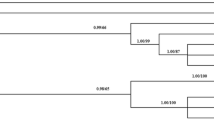Abstract
To determine the relationship ofNeospora caninum to protozoa classified in the family Sarcocystidae of the phylum Apicomplexa, the genomes ofN. caninum, threeToxoplasma gondii strains (RHa, CEP, TPR) and threeSarcocystis species (S. tenella, S. muris, S. gigantea) that were thought to be closely related coccidia were compared by the random amplified polymorphic DNA (RAPD) polymerase chain reaction (PCR) technique. The genomic DNAs were amplified by the use of seven 10-mer arbitrary sequence primers to generate polymorphic DNA. Significant DNA polymorphisms were observed amongNeospora, Toxoplasma andSarcocystis. It appears that one primer tested may have value in a diagnostic RAPD-PCR to differentiateT. gondii from other closely related protozoa. The high level of genetic divergence ofN. caninum fromT. gondii strains and severalSarcocystis species observed in this study is consistent with the hypothesis thatN. caninum is indeed an independent species of protozoan parasite. As compared with theSarcocystis species tested, a closer genetic relationship ofN. caninum toT. gondii was not observed. By contrast, a closer genetic relationship ofS. muris toT. gondii was revealed in this study.
Similar content being viewed by others
References
Barral V, This P, Imbert-Establet D, Combes C, Delseny M (1993) Genetic variability and evolution of theSchistosoma genome analysed by using random amplified polymorphic DNA markers. Mol Biochem Parasitol 59:211–222
Brindley PJ, Gazzinelli RT, Denkers EY, Clark GC, Waters AP, Davis S, Dubey JP, Belfort JR, Martins M-C, Silveira C, Jamra L Sher A (1993) Differentiation ofToxoplasma gondii from closely related coccidia by riboprint analysis and a surface antigen gene polymerase chain reaction. Am J Trop Med Hyg 48:447–456
Carson CA, Brandt HM, Jensen JB, Bailey CW, Allen GK (1994) Use of random amplifed polymorphic DNA analysis to compareBabesia bovis andB. bigemina isolates. Parasitol Res 80:312–315
Clark AG, Lanigan CMS (1993) Prospects for estimating nucleotide divergence with RAPDs. Mol Biol Evol 10:1096–1111
Dubey JP, Lindsay SD (1993) Neosporosis. Parasitol Today 9:452–458
Ellis J, Luton K, Baverstock P, Brindley PJ, Nimmo K, Johnson AM (1994) The phylogeny ofNeospora caninum. Mol Biochem Parasitol 64:303–311
Ellis J, Luton K, Barverstock PR, Whitworth G, Tenter AM, Johnson AM (1995) Phylogenetic relationships betweenToxoplasma andSarcocystis deduced from a comparison of 18S rRNA sequences. Parasitology (in press)
Felsenstein J (1985) Confidence limits on phylogenies: an approach using the bootstrap. Evolution 39:783–791
Felsenstein J (1993) PHYLIP (phylogeny inference package) version 3.5c. Distributed by the author. Department of Genetics, University of Washington, Seattle
Guo Z-G, Johnson AM (1995) Genetic characterization ofToxoplasma gondii strains by random amplified polymorphic DNA polymerase chain reaction. Parasitology (in press)
Holmdahl OJM, Mattsson JG, Uggla A, Johansson K-E (1994) The phylogeny ofNeospora caninum andToxoplasma gondii based on ribosomal RNA sequences. FEMS Microbiol Lett 119:187–192
Johnson AM, Dubey JP, Dame JB (1986) Purification and characterization ofToxoplasma gondii tachyzoite DNA. Aust J Exp Biol Med Sci 64:351–355
Lindsay DS, Dubey JP (1989) In-vitro development ofNeospora caninum (Protozoa: Apicomplexa) from dogs. J Parasitol 75:163–165
Lindsay SD, Speer CA, Toivio-Kinnucan M, Dubey JP, Blagburn BL (1993) Comparative ultrastructure ofNeospora caninum from dogs andToxoplasma gondii in cultured cells. Am J Vet Res 54:103–106
Luton K, Gleeson M, Johnson AM (1995) rRNA gene sequence heterogeneity amongToxoplasma gondii strains. Parasitol Res (in press)
Nei M, Li W-H (1979) Mathematical model for studying genetic variation in terms of restriction endonucleases. Genetics 76:5269–5273
Olsen GJ, Woese CR (1993) Ribosomal RNA: a key to phylogeny. FASEB J 7:113–123
Scott JC, McManus DP (1994) The random amplification of polymorphic DNA can discriminate species and strains ofEchinococcus. Trop Med Parasitol 45:1–4
Tenter AM, Baverstock PR, Johnson AM (1992) Phylogenetic relationships ofSarcocystis species from sheep, goats, cattle, and mice based on ribosomal RNA sequences. Int J Parasitol 22:503–513
Welsh J, McClelland M (1990) Fingerprinting genomes using PCR with arbitrary primers. Nucleic Acids Res 18:7213–7218
Williams JGK, Kubelik AR, Livak KJ, Rafalski JA, Tingey SV (1990) DNA polymorphism ampified by arbitrary primers are useful as genetic markers. Nucleic Acids Res 18:6531–6535
Williams JGK, Hanafey MK, Rafalski JA, Tingey SV (1993) Genetic analysis using random amplified polymorphic DNA markers. Methods in Enzymol 218:705–740
Author information
Authors and Affiliations
Rights and permissions
About this article
Cite this article
Guo, ZG., Johnson, A.M. Genetic comparison ofNeospora caninum withToxoplasma andSarcocystis by random amplified polymorphic DNA-polymerase chain reaction. Parasitol Res 81, 365–370 (1995). https://doi.org/10.1007/BF00931495
Received:
Accepted:
Issue Date:
DOI: https://doi.org/10.1007/BF00931495




